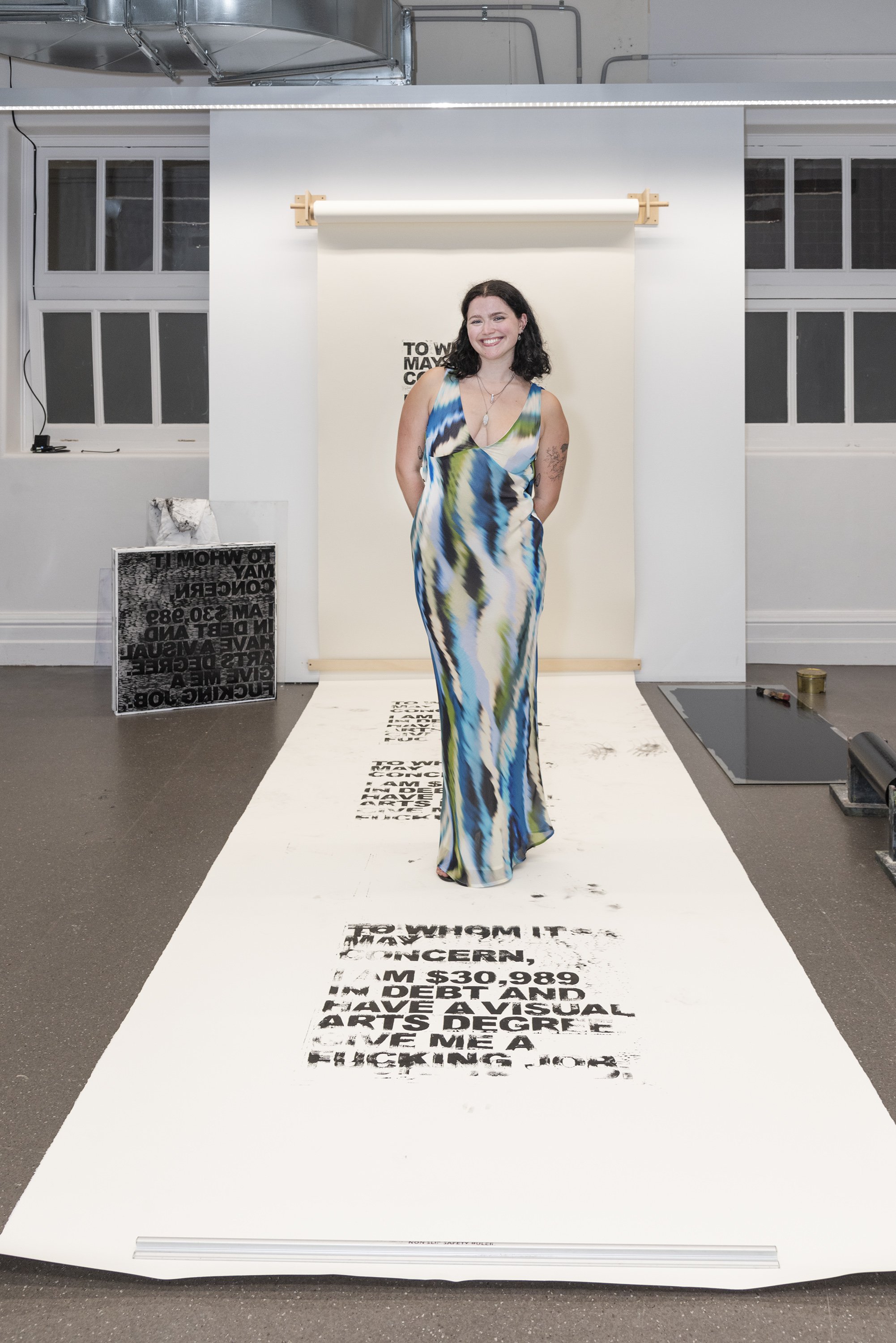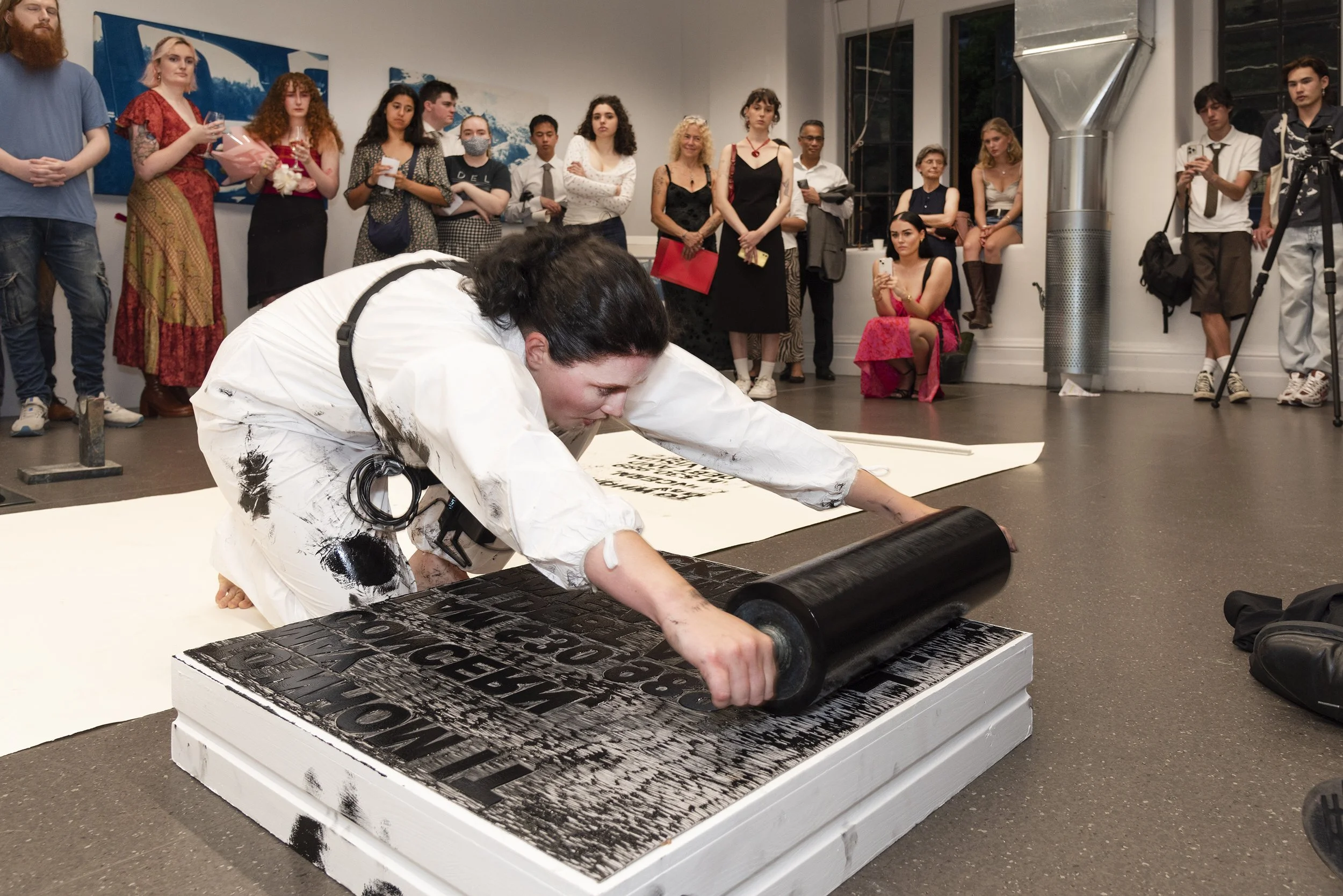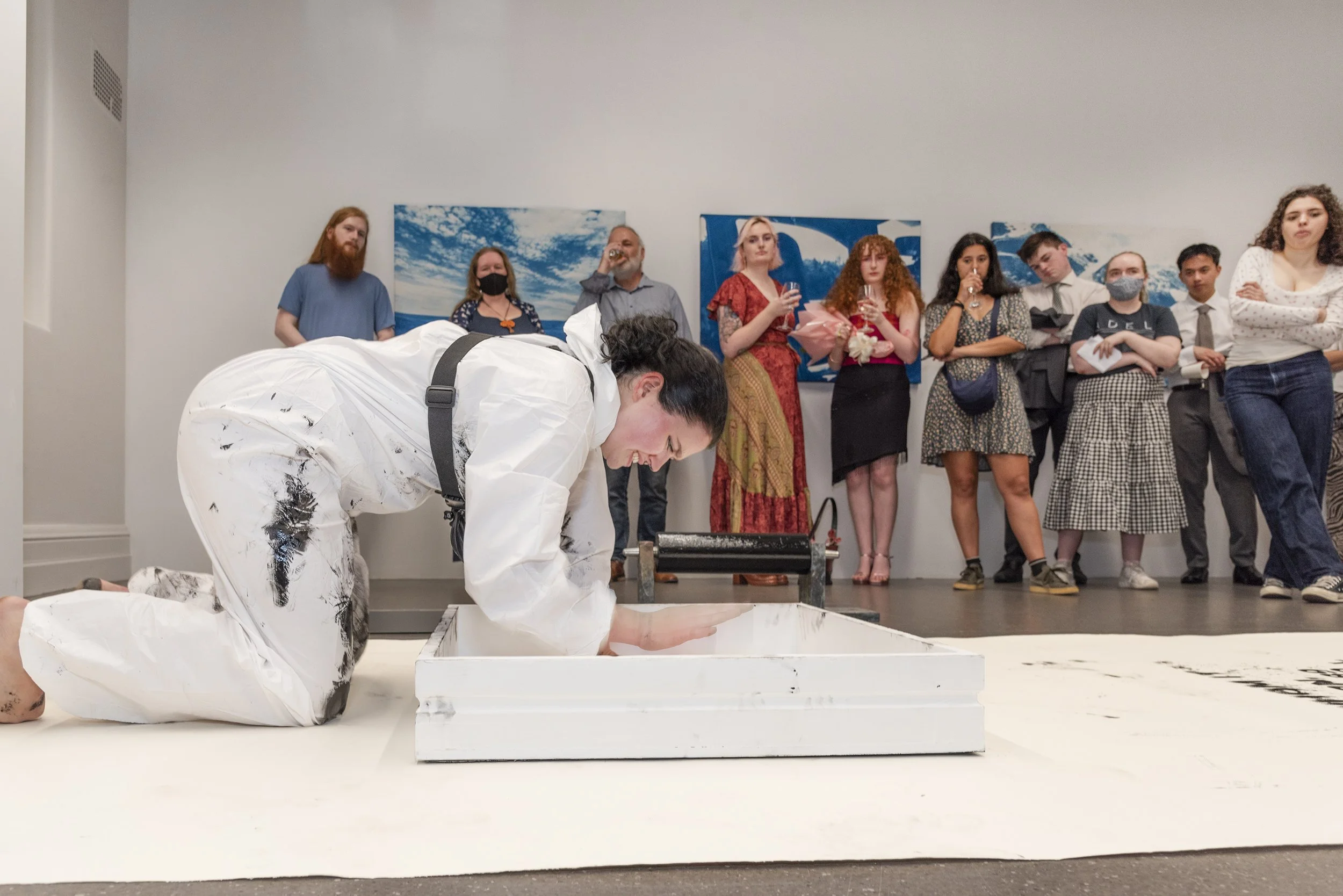Photography by Gary Trinh.
Teeya Ryan
Teeya Ryan is an emerging Australian artist working on unceded Gadigal land, exploring and experimenting the possibilities and intersections between print-media and performance art. With a theoretical grounding in labour and work, Ryan’s practice is most heavily concerned with how her body is implemented in the process of creation. She is currently working on her Honours degree in English while continuing to experiment and expand her print-media practice.
Teeya Ryan, TO WHOM IT MAY CONCERN, 2024, performance installation (pre-performance). Image courtesy of SCA Document Photography.
Tell us about your creative process. What drives your practice?
There are three major themes that really define my practice: labour, the body, and performance. I feel like there are so many questions and answers to be found within those three ideas that I’ll probably be making art about it for a very long time. The way I’ve come to describe what I’m working with (or rather, working towards) is finding and making work within the intersection between print-media and performance art.
Early in my introduction to the print studio, I was overwhelmingly aware of the amount of physical labour I was doing within that space. If you stand still in the print room, you’ll very quickly become aware of just how much we move in that space – it’s almost like a performance. I find that the print studio, or any space really that you dedicate to artmaking (right now, it’s my bedroom floor or my apartment complex carpark) is so much more active and interesting than the gallery. I did a lot of reading on the “white cube” during my under-grad and have since become fascinated in how we can dismantle the rigidity of gallery spaces and institutions. Trying to figure that out is what keeps me writing and working.
Can you tell us more about the intersection between print-media and performance in your artistic process and research?
If you couldn’t already tell, I can’t stop ruminating on how our bodies are implicated in the creation of a print. Our bodies are an integral part of printmaking, and yet, in those final prints the human touch is often as close to erased as possible. So much of print-media, especially in a commercial sense, is focused on editioning, clean lines and perfect registration; we are all artists just trying to create that elusive perfect print. But the process, more than the final product, is far more interesting to me on a conceptual level. I think there’s a lot of energy in making visible this invisible process.
I think finding what exists in the intersection between performance and print-media is about allowing that process – that invisible labour – to become the work. What happens when we allow the process to become the product? I just feel like this is such a rich area to be working in, and I feel so lucky that it’s a space I’ve found and really delved into.
Teeya Ryan, TO WHOM IT MAY CONCERN, 2024, performance installation, live-printed lino-cut stamp. Photography by Gary Trinh.
How do notions of labour inform your practice? In particular relation to the Australian arts ecology and workforce, as well as printmaking as a medium.
Maybe I sound like a broken record, but again, the body is the vessel that performs all of this labour. It’s my arms, my hands, my wrists, and shoulders that carve away at each piece of lino or wood. When I run something through the press, it’s my feet and my legs that keep me steady.
When I create three-hundred and ninety-two versions of a single etching (I did this in second year and it was a lot of work), it’s my body that bears the brunt of that labour. I find it difficult, in all the ways I create, to ignore just how much physical labour artmaking requires.
It's also hard to ignore what labour means and does within the Australian economy and workforce. My largest work to date, TO WHOM IT MAY CONCERN (2024), was borne from a deep-seated concern I know that many of my peers were feeling as we neared the end of our degrees. I was exiting art school with very little understanding of where to go next, and honestly, I’m still not quite sure what I’m doing! All of us were faced with a choice: either further our studies or move into a workforce that primarily consists of unpaid labour, excessive self-promotion and grant proposals that most often go nowhere.
Your practice seems innately subversive and provocative in its intent. Can you expand on how resistance is explored in how you approach art making?
I don’t think I have to make any big claims about the state of our world right now – it feels like a really scary place. And with so many voices clamouring to be heard, it’s hard not to create something that yells out to be seen. As we’ve seen with a lot of big movements this year – particularly in support for Palestine – it’s not enough to just talk about things anymore. We need to act. The more noise we keep making for the things that we care about, the more we can make people listen.
I’m so angry with so many things happening in our world right now, and since finishing up my bachelor’s, my practice has shifted slightly to consider how my work can be a protest, not just an artwork. And, selfishly, the process of these performances is really cathartic to me – there’s really no other place that I can stamp and punch and yell about the things that make me so angry and the things that I really care about. It’s a very healing thing for me personally, and I hope those emotions translate to the audience around me too.
Teeya Ryan, TO WHOM IT MAY CONCERN, 2024, performance installation, live-printed lino-cut stamp. Photography by Gary Trinh.
Are there any female printmakers/artists that influence you?
I adore the work of Carolee Schneemann and Julie Rrap. Their work inspires me to be unafraid in my artmaking, and really helped me reimagine my body as more than a vessel used to create but as a material integral to an artwork. When I began to really dive deep into how labour, performance and art were all entangled, I stumbled across the work of Mierle Laderman Ukeles – particularly Washing/Tracks/Maintenance: Outside (July 23rd, 1973) – and remember just sitting with those images for a long time. It was the first time I’d considered how I could make a process or task a piece of art. It’s easily one of the most important pieces of art in my personal research.
And even though her work isn’t necessarily connected to mine, I have always been in awe of Judy Watson’s work. I remember studying her in my year nine art classroom. It was her prints that first made me realise what print-media was and all that it could be.
Finally, what exciting projects are you working on at the moment?
I am very lucky to have just confirmed an exhibition with Airspace Projects in October 2025! So, I have a couple of months of experimenting heavily ahead of me before I bring something new into the world.
I am also currently completing my Honours degree in English, and will hopefully be having some work published online throughout the year too! Right now, I’m just trying to stay creative and find those outlets to get my work into the world. There’s a lot of pressure on emerging artists to get their work out as quick as possible, but the reality is that our arts economy is working against us! Sometimes the most we can do (or afford) is a quick Instagram post, and I think it’s important to recognise that as valid too.
Teeya Ryan, TO WHOM IT MAY CONCERN, 2024, performance installation, live-printed lino-cut stamp. Photography by Gary Trinh.





